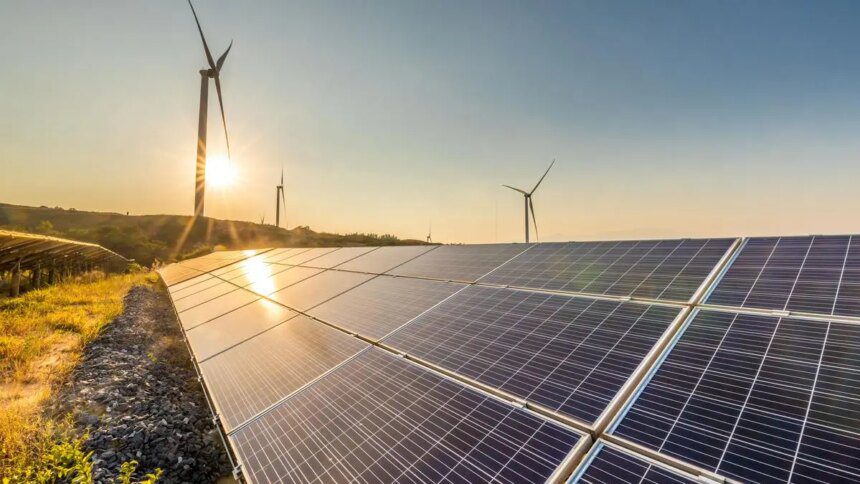India reached a significant milestone in August by surpassing the 250 GW mark in installed non-fossil fuel power capacity, primarily driven by a surge in solar energy. This figure represents a crucial midpoint in the country’s goal of achieving 500 GW of non-fossil energy capacity by 2030.
Excluding nuclear energy and large hydroelectric projects, India’s renewable energy capacity is approximately 192 GW. When nuclear and large hydro are included, the total non-fossil fuel-based capacity amounts to 251,405 MW. The overall installed capacity of power stations in India has exceeded 495 GW, meaning that non-fossil fuel sources now account for 50.7% of the total power capacity, marking the first time this proportion has exceeded half.
While thermal sources, such as coal, lignite, and gas, remain the dominant forces with about 244 GW, renewable energy has made significant advances, with solar alone contributing roughly 123 GW. The current fiscal year has witnessed remarkable growth in solar installations, which added 17,483 MW in the first five months. Ramneek Sehgal, Chairman and Managing Director of Ceigall India, noted, “Solar power is the backbone of India’s renewable expansion,” following the company’s successful bid for a 337-MW solar power project with the Maharashtra State Electricity Distribution.
In contrast, the pace of wind energy capacity additions has been slower, with only 2,643 MW added in the same timeframe. As of June 2025, approximately 142 GW of renewable energy capacity is under construction, reflecting a robust pipeline for future growth.
Hybrid projects, combining solar and wind elements, are contributing positively to the non-fossil fuel initiative. These projects help mitigate the intermittency challenges associated with pure solar or wind installations. Currently, hybrid projects encompass close to 30 GW of under-construction capacity, according to the Renewable Project Monitoring Division of the Central Electricity Authority. The complementary nature of solar (which peaks midday) and wind (frequently stronger at night) enhances system efficiency, potentially raising capacity factors to around 40%, compared to 18-28% for standalone systems.
Energy storage solutions are also becoming increasingly relevant. Pranaav Gupta, Senior Associate at Economic Laws Practice (ELP), highlighted recent regulatory changes. In August, the Ministry of Power exempted “off-stream closed-loop” pumped storage schemes from needing consent from the Central Electricity Authority (CEA), reducing regulatory burdens.
Complementing the expansion of non-fossil fuel sources, India’s nuclear energy capacity now stands at 8,780 MW. However, the sector faces operational challenges due to complex maintenance needs and occasional outages. Despite these issues, nuclear power remains a stable contributor. India targets 100 GW of nuclear capacity by 2047, with the government allocating ₹20,000 crore under its Nuclear Energy Mission to develop Small Modular Reactors.
Nonetheless, challenges lie ahead, as noted by Sehgal. He estimates that nearly 25% of awarded renewable projects may experience delays past the 2030 deadline due to several factors. “Delays in the establishment of transmission infrastructure present significant roadblocks, with over 50 GW of new renewable capacity currently stranded as the transmission network fails to keep pace,” he stated. In FY25, only 8,830 circuit kilometers (ckm) of new lines were commissioned, falling short of the 15,253 ckm target.
Systemic issues contribute to delays in renewable energy projects. Gupta cited an example of a solar power plant’s commercial operation date being delayed because the Model Code of Conduct was in effect, which led to a scarcity of personnel for necessary approvals.
Acquiring large tracts of land for solar and wind energy installations remains a challenge, complicated by property fragmentation, legal disputes, and community opposition, particularly concerning extensive solar parks and transmission corridors. Uncertainty surrounding power purchase agreements (PPAs) also hampers expansion, with over 40 GW of awarded renewable projects lacking signed agreements, which may necessitate rebidding due to absent supply deals. Meeting the 500 GW target by 2030 now hinges on execution reform and risk mitigation across land, grid, and policy areas.
Published on September 29, 2025.










